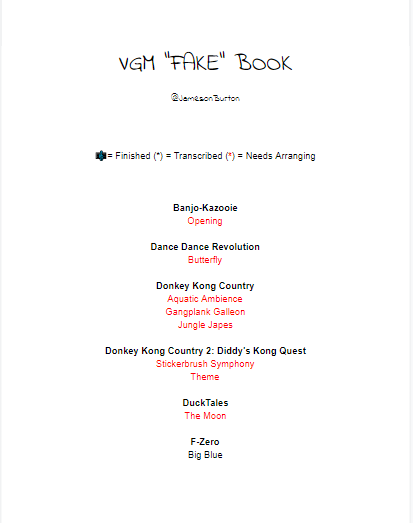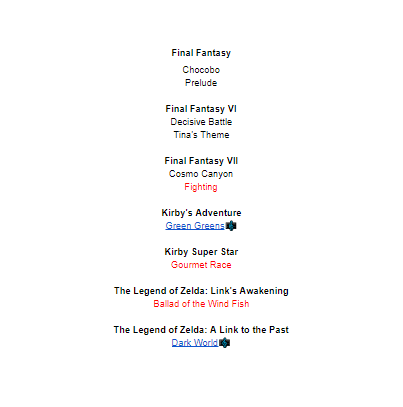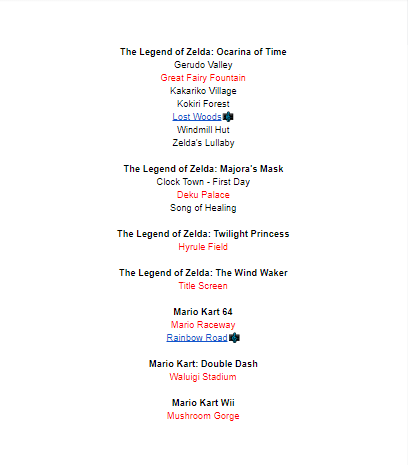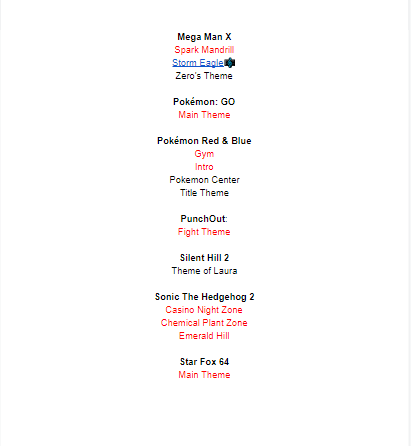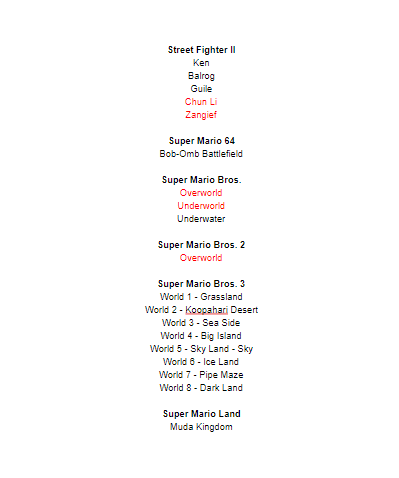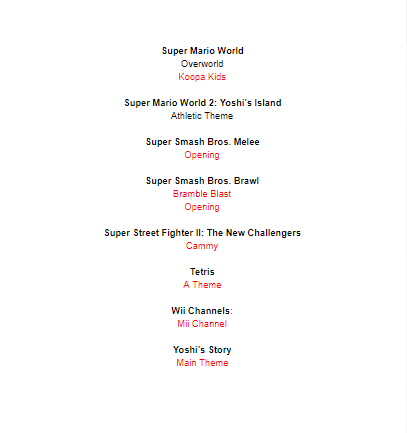Leaderboard
Popular Content
Showing content with the highest reputation on 08/29/2021 in all areas
-

MnP 126: Pokemon Gold/Silver - National Park
Souperion and 2 others reacted to Wassup Thunder for a topic
Got a vote in3 points -

MnP 126: Pokemon Gold/Silver - National Park
TheVideoGamer and one other reacted to APZX for a topic
@Souperion Had the same issue, if you select the blank entry it will be Coloradoweeks'. I had the same concern and checked with @TheVideoGamer and my vote went through as anticipated2 points -

MnP 126: Pokemon Gold/Silver - National Park
TheVideoGamer reacted to APZX for a topic
@The Vodoú Queen In a situation like that is where the art of mixing comes into play. I can do a lot to make a mix cleaner & clearer even without panning. Take your track for example. I'll just start from where you go full electronic. The build-up and transition are fine and you've got a small bit of wall of sound going on. You've got decent transient information there to work with as well. The instrument voicing is perhaps not the most conducive to making it sound huge because there is too much in the 600Hz to 2KHz range going on. Now, thankfully in the electronic realm there is a technique that is super useful. It is called Sidechain compression*. In this particular case the most probable course of action would be to sidechain the main synth sound to the kick. Bring the kick into the center then sidechain the main stab to allow the kick to come through more clearly. Another option is to force the kick to pump a compressor. Here what you do is route the main synth sound to another channel and then send the kick there as well. Then you simply start turning up the volume of the kick to the point where it causes the compressor to react to the kick primarily. To create even more room for the kick in there as well. On the main synth if you take out say (just guessing here) about 3-4dB around 100-200Hz and then do the opposite for the kick you've given the kick a little more room to hit a smidgen harder. Something else I'd do here is on the other bits of percussion, I'd route them all to their own channel and add a bit of transient designer to them for a little extra attack. Something else to consider is that your main synth there is also providing your low end. So, you'd want to give that some more weight in the form of say something like a low shelf around 50-80Hz. Or alternatively you can let the kick win there, by high passing the main synth say around 80-100Hz and then boosting the kick's bottom end in a similar fashion that you would for the main synth. The next bit of concern is the additional synth you bring in. It also has a fair bit of lows. Now, me personally from what I'm hearing I'd take out some of the main synth's 300-900Hz region and give that to the other synth, while giving the additional synth a high boost with a very very wide high shelf (I'd start with the shelf around 20KHz and bring it down until I got the effect I want). Further, for the main synth I'd also compress the ever living snot out of it. I think something like an 1176 style compressor here would be great. Set it for say 4:1, attack middle-ish, and release as fast as it'll go (that'll be all the way clockwise). Then aim for a lot of gain reduction (I'd say 6-12dB would be a good starting point). Then for the last bit of polish on the additional synth that comes in. I'd go for some gentle compression, likely an opto (or a VCA can be used if the attack is set long and the release is set short too). The aim here is to do some gentle leveling of the sound. Just ride the overall dynamics and just squeeze them down a little as it were. Don't forget to pull some of the lows out of the sound as well. For the hats. They're simply too quiet, and honestly I think just a level boost is all they'd need. Maybe a bell centered around 6-8KHz to bring out the attack a little bit more. The clap just needs a level boost to my ears. If you paired that up with a transient designer you could really bring them forward in the mix. The trick to loud is much more in the composition rather than the mix though. The instruments have to have the room to breathe. Selecting which instruments play when and controlling the voicing of the instruments such that the actual desirable part of the sound does not conflict with another. The other thing is to watch the amount of low end you put into the track. The more low end, the quieter it is going to be simply because for us to perceive lows there needs to be more level. The more level the harder it is to make that sound loud without making a limiter sound bad. And that is probably the last thing, just a good overall spectral balance of the mix. If you were to take an average spectral view of commercial tracks, you'd see that generally it tends towards the shape of pink noise. Another trick is to actually use more highs. This does not generally make the track any louder, but it makes it appear louder, but be careful you don't overdue it Okay enough waffling. * - I really do not like this term, but it is what it is. To start the basic anatomy of a compressor. I'll assume the feedforward topology for this explanation (the difference between a feedfoward and feedback compressor are where the sidechain of the compression is fed from. In a feedforward design it happens before the gain reduction element and in a feedback design it happens after the gain reduction element). There is an input buffer and the signal is then sent to both the sidechain and gain reduction element simultaneously. The sidechain consists of multiple parts on its own, but functionally it consists of a detector of some sort (RMS, peak, or average typically) feeding into a comparator of some sort (determines whether the signal is above the threshold of the compressor) that is then fed into an envelope shaper of some sort (this is what gives the compressor its attack & release characteristics). Now, the entire job of the sidechain is to control the gain reduction element such that whenever the signal goes above the threshold the gain reduction element will begin to turn down the signal. The thing is though that a compressor is functionally two different major circuits. One is the audio path where the signal passes through the gain reduction element and the other is the sidechain circuit. Knowing this, it is possible to disconnect the audio path from the sidechain and then feed in whatever signal you want into the sidechain; thereby, effectively compressing any signal with another signal. Some examples are whenever you listen to an EDM song and when the kick hits everything just seems to duck out of the way of it? Yeah that is sidechain compression. Another useful place is when you're trying to fit in vocals around a bunch of guitars in say a rock track. Often the most desirable frequencies for both instruments are in the same region one thing you can do is duck the guitars around the vocals a bit by using sidechain compression. This same technique can also be applied to gates. Ever listen to a Trance track and here some nifty gated instruments? That can be done using a gate and something like a simple square wave feeding the sidechain of the gate1 point -

MnP 126: Pokemon Gold/Silver - National Park
TheVideoGamer reacted to HoboKa for a topic
Whew! I'm glad that that's now @TheVideoGamer's problem to work out haha. It's things like this that made me realize I was burnt out at the Compo Host gig. Er...don't quit on us just yet TheVideoGamer. I'm sure that Starla and Ramanescence can fix it quickly. Maybe I'll throw my hat in next round, depending on the source-pick. Cheerio~1 point -

MnP 126: Pokemon Gold/Silver - National Park
TheVideoGamer reacted to Souperion for a topic
Casting my vote, but coloradoweeks' entry doesn't show up for voting selection. :S1 point -
.thumb.jpg.f98077b6fd51f6b897a7fd487af59377.jpg)
PRC431 - On A Different Planet With Rings (Godzilla)
Souperion reacted to TheVideoGamer for a topic
Yo dudes it's me! As you can tell i missed quite a few rounds, both submitting and voting. Well truth be told is, i was on vacation for 9 days, and i usually don't bring my software with me, nor do i type well on a phone. That combined with very busy areas and low signal, so i couldn't submit any music, or upload any voting. I have GarageBand, but it's not the best for remixing personally, and i'm not always sitting making music, i'm exploring and doing other things. Now i got back a few days ago, and since then i've been busy adjusting to normal life, so i haven't had the chance to vote or submit. But since i am here, i will listen to the rounds i've missed, and try to provide feedback (Both MnP and PRC). Congrats to the winners of all these rounds! Hope your days are as good as mine! All the best!1 point -
Hi everyone, I'm not sure if this is the right place for this post, but this is a bit of an "art" project to me. I've been making a VGM "Fake Book" (it's like a compilation of charts with rhythm notation, chord charts, and two monophonic voices harmonized in a typical jazz arrangement style), and I wanted to share the progress with OCR in case anyone could get some use out of it. I suppose, in some sense, this is my "visual art project" relating to game music. It is a labor of love, so it is incomplete but entries are always being added to it. I'm in the phase of adding the finalized products to the book (many pieces are already transcribed/reharmonized and just lacking final draft) and would love some feedback from the community. I'm not making the whole book available to the public, but I'd like to share some excerpts and see what you think! Table of contents: I've included a .pdf file of "Dark World" from A Link to the Past. You'll notice that my sheets are made into two main sections: "Head" Think of the top line as the main melody, second line as optional harmony/counterpoint. "Vamp" The top line is what most of the accompaniment is providing in the source recordings, but re-voiced/re-harmonized in some instances that I found necessary. I didn't just sit with these pieces and add "7"s to every chord to make it "jazz". The basslines are an attempt to make a 1-1 transference of some bass lines if I find them particularly iconic (it may not be up to me to judge), but may be simplified in some places for "ease of use". The notes are written with an "X" instead of a traditional note-head because I wanted these to indicate rhythm as well, not just pitch. There are chords notated above the top line of the "Vamp". I believe them all to be accurate and have taken some liberties (but nothing too out there) where I heard implied harmony. I was mostly looking out for improvisers and guitarists. The idea was to have the pieces as informative as possible, while also making a clean and comprehensive chart that is easy to sight read. You can take this info and rearrange it for so many mixed groups! I am looking for feedback in the following areas: Ease of Use Accuracy of Melody Harmonic Interpretation Legibility/Comprehension Anyone taking the time to review and critique would have my personal thanks and I'd be happy to provide them more sheets for their time (if interested). Thank you! VGM Fake Book - Dark World.pdf1 point
-
SUPER HIDDEN REMIXES
NovemberRhythm reacted to captaineegee for a topic
I just checked that site out and was surprised to see Bottled Fairy there - I could have sworn I heard it here recently.0 points


